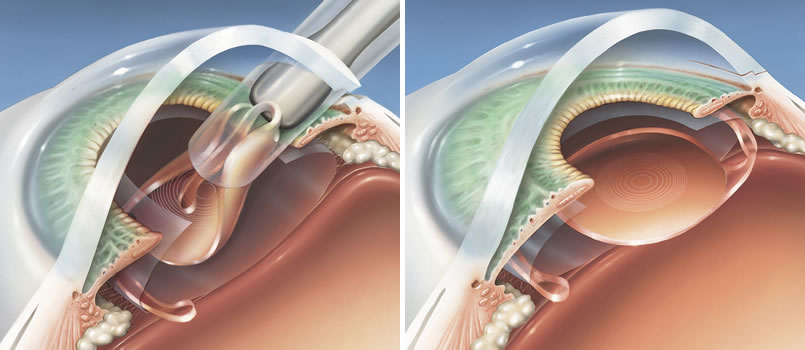What is a cataract?

A cataract is a clouding of the lens inside the eye. There are different types of cataract occurring at different positions inside the lens.
The most common form of cataract is an extension of the normal ageing and yellowing of the lens.
This results in a blurring of vision like looking through frosted bathroom glass. Other types of cataract can lead to glare from car headlights and bright sunlight.

How does a cataract form?
The most common form of cataract is due to normal ageing of the lens. Some eye conditions such as glaucoma can make cataract more common. Drugs such as steroids can cause cataract and injuries to the eye can lead to cataract. It is possible to inherit a genetic form of cataract, and diabetes means that on average a patient will develop a cataract 5 years earlier than he or she would do otherwise.
How is a cataract removed?

Cataracts are removed using a technique called phacoemulsification. This involves using an ultrasound probe to break up the cataract into small pieces. These can then be removed from the eye by suction (aspiration). The advantage of this technique is that only a small cut in the eye is required that doesn’t need a stitch at the end of the operation.
A folding implant is then inserted through the same small incision, which opens up inside the eye like a ship in a bottle.

Cataract surgery is usually carried out under local anaesthesia as a day case, without the need for an overnight stay in hospital.
“I would like to say a huge thank you for your skill, expertise and professionalism in your approach to and care of myself.” Mrs U, Devizes
What to expect before surgery
You will need an assessment before the operation to confirm that you have a cataract and that your eye is otherwise healthy. Measurements are also taken of your eye and a computer program used to work out which is the best implant for your eye. For this visit you will need drops put in your eye to make the pupil larger. These make your eyesight blurred for a few hours so it is better if you do not drive yourself. The type of anaesthetic to be used will also be discussed.
What to expect on the day of surgery
On the day of surgery you will need to come to the hospital about an hour before the operation. This is so that drops can be put into your eye to make the pupil larger. You will be brought along to the operating theatre where the local anaesthetic will be inserted. This can either be just drops or a no-needle infusion. You will then need to lie flat and still for about 10 minutes. Your eye is cleaned with antiseptic, and then covered with a sterile sheet called a drape. There will be a bar in front of your eye with a constant flow of oxygen coming out so that there is plenty to breathe.
After the surgery you will have a clear plastic shield over your eye. The hospital will keep you for 30 to 60 minutes to make sure you are not reacting to the drops. What to expect after the operation
Your eyesight will be blurred on the day of the operation and you may have some double vision. By the next day your eyesight will start to become clear. You will be given eye drops to put in usually for about a month. Your eye may be a little red for a few days and will feel gritty as though you have something in your eye. This may last a few weeks. Your eyesight will be blurred for reading until you can get reading glasses from your optician. This is best done after 3 to 4 weeks.
Risks of the procedure
As with any operation, cataract surgery carries small risks. The most important risk is infection (endophthalmitis). This occurs in about 1 case in 4000 to 5000. At its worst it can mean that your eye is effectively blind. This is very rare however. Other risks include tearing of the capsule that holds the lens in place, retinal detachment, haemorrhage at the back of the eye and swelling of the retina after the surgery.
Can cataracts come back?
Once the cataract has been removed it cannot come back. Your implant will usually have been placed inside the same capsule that held the original lens in place. Sometimes the capsule itself can become cloudy, which affects your eyesight in the same way as a cataract. This happens to about 1 in 20 people usually after about a year, and can easily be treated by a laser without an operation.
